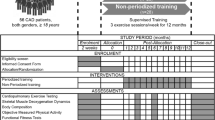Abstract
Cardiac rehabilitation services are comprehensive long term programmes designed to limit the physiological and psychological effects of cardiovascular disease (CVD), control cardiac symptoms and reduce the risk of subsequent CVD events by stabilising or partially reversing the underlying atherosclerosis process through risk factor modification. Exercise training is the cornerstone of such programmes. Ideally, exercise conditioning or training for the stable cardiac patient should include a combination of cardiorespiratory endurance (aerobic) training, arm exercises and muscular conditioning resistance (strength) training. Flexibility exercises should also be performed, usually as part of the warm-up and cool-down routines preceding and following endurance and strength training. This review discusses the potential physiological, psychological and health benefits of regular exercise and provides guidelines for exercise training for the rehabilitation of post-myocardial infarction patients following hospitalisation.
Similar content being viewed by others
Notes
1 MET is the energy requirement of sitting rest approximately equal to 3.5ml of oxygen uptake per kg of bodyweight per minute.
References
U.S. Department of Health and Human Services. Clinical practice guidelines, no. 17. Cardiac rehabilitation. AHCPR publication no. 96-0672. Rockville (MD): U.S. Department of Health and Human Services, 1995
Hamm LF, Leon AS. Exercise training for the coronary patient. In: Wenger NK, Heller Stein HK, editors. Rehabilitation of the coronary patient. 2nd ed. New York (NY): Churchill Livingston, 1992: 367–402
American College of Cardiology Task Force. Recommendations of the American College of Cardiology on Cardiovascular Rehabilitation. J Am Coll Cardiol 1986; 7: 451–3
World Health Organization Expert Committee. Rehabilitation after cardiovascular disease, with special emphasis on developing countries. Technical report series no. 381. Geneva: World Health Organization, 1993
Pollock ML, Welsch MA, Graves JE. Exercise prescription for cardiac rehabilitation. In: Pollock ML, Schmidt DH, editors. Heart disease: heart disease and rehabilitation. 3rd ed. Champaign (IL): Human Kinetics, 1995: 243–76
Leon AS. Position paper of the American Association of Cardiovascular and Pulmonary Rehabilitation scientific evidence of the value of cardiac rehabilitation services with emphasis on patients following myocardial infarction: exercise conditioning component. J Cardiopulm Rehabil 1990; 10: 79–87
McCartney N. Role of resistance training in heart disease. Med Sci Sports Exerc 1998; 30 (10 Suppl.): S396–402
Shephard RJ, Balady GJ. Exercise as cardiovascular therapy. Circulation 1999; 99: 963–72
Charo S, Gorce N, Vita JA. Endothelial dysfunction and coronary risk reduction. J Cardiopulm Rehabil 1998; 18: 60–7
Sessa WC, Prichard K, Seyedi N, et al. Chronic exercise in dogs increases coronary vascular nitric oxide production and endothelial cell nitric oxide synthase gene expression. Cite Res 1994; 74: 349–53
Laughlin MH, Oltman CT, Bowles DK. Exercise training-induced adaptations in the coronary circulation. Med Sci Sports Exerc 1998; 30: 352–60
Kramsch DM, Aspen AJ, Abramowitz BM, et al. Reduction in atherosclerosis by moderate conditioning exercise in monkeys on an atherogenic diet. N Engl J Med 1981; 305: 1483–9
Haskell WL, Alderman EL, Fair JM, et al. Effects of intensive multiple risk factor reduction on coronary atherosclerosis and clinical cardiac events in men and women with coronary artery disease: the Stanford Coronary Risk Intervention Project (SCRIP). Circulation 1994; 89: 875–90
Schuler G, Hambrecht R, Schlierf G, et al. Myocardial perfusion and regression of coronary artery disease in patients on a regimen of intensive physical exercise and low fat diet. J Am Coll Cardiol 1992; 19: 34–42
Ornish D, Brown SE, Scherwitz LW, et al. Can lifestyle changes reverse coronary artery disease? The lifestyle heart trial. Lancet 1990; 336: 129–33
Leon AS. Contributions of regular moderate-intensity physical activity to reduced risk of coronary heart disease. In: Leon AS, editor. National Institutes of Health. Physical activity and cardiovascular health: a national consensus. Champaign (IL): Human Kinetics, 1997: 57–66
American College of Sports Medicine. ACSM’s guidelines for exercise testing and prescription. 5th ed. Baltimore (MD): Williams & Wilkins, 1995
American Association of Cardiovascular and Pulmonary Rehabilitation. Guidelines for cardiac rehabilitation programs. Champaign (IL): Human Kinetics, 1991
Parmley WW. Position report on cardiac rehabilitation: recommendations of the American College of Cardiology on cardiovascular rehabilitation. J Am Coll Cardiol 1986; 7: 451–3
DeBusk RF, Blomqvist CG, Kouchoukos NT, et al. Identification and treatment of low-risk patients after acute myocardial infarction and coronary artery bypass graft surgery. N Engl J Med 1986; 314: 161–6
Franklin BA, Hellerstein HK, Gordon S, et al. Cardiac patients. In: Franklin BA, Gordon S, Timmis GC, editors. Exercise in modern medicine. Baltimore (MD): Williams & Wilkins, 1989: 44–80
Fletcher GF, Froelicher VF, Hartley LH, et al. Exercise standards: a statement for health professionals from the American Heart Association. Circulation 1990; 82: 2286–322
Wasserman K, Hansen JE, Sue DY, et al. Principles of exercise testing interpretation. 2nd ed. Philadelphia (PA): Lea & Febiger, 1994
Borg GAV. Psychophysiologic bases of perceived exertion. Med Sci Sports Exerc 1982; 14: 377–81
Hellerstein HK. Exercise therapy in coronary disease. Bull N Y Acad Med 1968; 44: 1028–47
Thompson PD, Moore GE. The cardiac risks of vigorous physical activity. In: Leon AS, editor. National Institutes of Health. Physical activity and cardiovascular health: a national consensus. Champaign (IL): Human Kinetics, 1997: 137–42
Acknowledgements
Dr Leon is supported in part by the Henry L. Taylor Professorship in Exercise Science and Health Enhancement and by the University of Minnesota Heart Disease Prevention Clinic. Appreciation is expressed to Marilyn Borkon for preparation of this manuscript, and to Barry Franklin for his thorough editorial review. This paper is dedicated to the memory of my dear friends Michael Pollock and Herman Hellerstein, both pioneers in the exercise rehabilitation of cardiac patients.
Author information
Authors and Affiliations
Corresponding author
Rights and permissions
About this article
Cite this article
Leon, A.S. Exercise Following Myocardial Infarction. Sports Med 29, 301–311 (2000). https://doi.org/10.2165/00007256-200029050-00002
Published:
Issue Date:
DOI: https://doi.org/10.2165/00007256-200029050-00002




